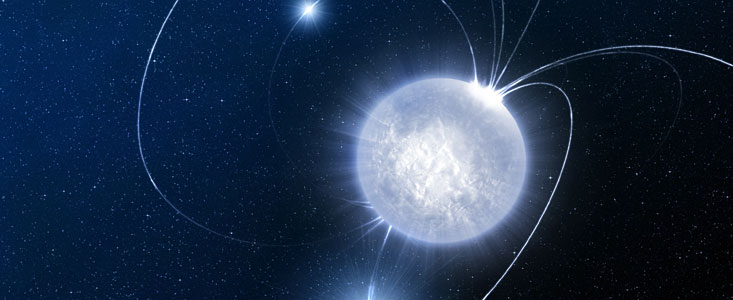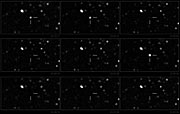Persbericht
The Hibernating Stellar Magnet
First Optically Active Magnetar-Candidate Discovered
23 september 2008
Astronomers have discovered a most bizarre celestial object that emitted 40 visible-light flashes before disappearing again. It is most likely to be a missing link in the family of neutron stars, the first case of an object with an amazingly powerful magnetic field that showed some brief, strong visible-light activity.
This weird object initially misled its discoverers as it showed up as a gamma-ray burst, suggesting the death of a star in the distant Universe. But soon afterwards, it exhibited some unique behaviour that indicates its origin is much closer to us. After the initial gamma-ray pulse, there was a three-day period of activity during which 40 visible-light flares were observed, followed by a brief near-infrared flaring episode 11 days later, which was recorded by ESO's Very Large Telescope. Then the source became dormant again.
"We are dealing with an object that has been hibernating for decades before entering a brief period of activity", explains Alberto J. Castro-Tirado, lead author of a paper in this week's issue of Nature.
The most likely candidate for this mystery object is a 'magnetar' located in our own Milky Way galaxy, about 15 000 light-years away towards the constellation of Vulpecula, the Fox. Magnetars are young neutron stars with an ultra-strong magnetic field a billion billion times stronger than that of the Earth. “A magnetar would wipe the information from all credit cards on Earth from a distance halfway to the Moon,” says co-author Antonio de Ugarte Postigo. "Magnetars remain quiescent for decades. It is likely that there is a considerable population in the Milky Way, although only about a dozen have been identified."
Some scientists have noted that magnetars should be evolving towards a pleasant retirement as their magnetic fields decay, but no suitable source had been identified up to now as evidence for this evolutionary scheme. The newly discovered object, known as SWIFT J195509+261406 and showing up initially as a gamma-ray burst (GRB 070610), is the first candidate. The magnetar hypothesis for this object is reinforced by another analysis, based on another set of data, appearing in the same issue of Nature.
Noten
Castro-Tirado A. J. et al. 2008, Flares from a candidate Galactic magnetar suggest a missing link to dim isolated neutron stars, Nature, 25 September 2008. A paper by Alex Stefanescu et al. in the same issue of Nature confirms the magnetar hypothesis.
The team is composed of A. J. Castro-Tirado, A. de Ugarte Postigo, J. Gorosabel, M. Jelinek, M. A. Guerrero, F. J. Aceituno, R. Cunniffe, P. Kubanek, S. Vitek (IAA-CSIC, Granada, Spain), T. A. Fatkhullin, V. V. Sokolov, E. Sonbas, S. A. Trushkin, N. N. Bursov, and N. A. Nizhelskij (SAO, Russian Academy of Science), P. Ferrero, D. A. Kann, S. Klose, and S. Schulze (Thuringer Landessternwarte Tautenburg, Germany), D. Sluse (Laboratoire d'Astrophysique, Ecole Polytechnique Fédérale de Lausanne (EPFL) Switzerland), M. Bremer and J.M.Winters (IRAM, Saint Martin d d'Heres, France), D. Nuernberger (ESO, Santiago, Chile), D. Perez-Ramirez (Universidad de Jaen, Spain and University of Leicester, UK), J. French, G. Melady, L. Hanlon, and B. McBreen (University College Dublin, Ireland), K. Leventis and S. B. Markoff (University of Amsterdam, The Netherlands), S. Leon (IRAM, Granada, Spain), A. Kraus (Max-Planck-Institut für Radioastronomie, Bonn, Germany), A. C. Wilson (University of Texas, Austin, USA), R. Hudec (Astronomical Institute of the Czech Academy of Sciences), M. Durant, J.M. Gonzalez-Perez, and T. Shahbaz (IAC, La Laguna, Spain), S. Guziy (Nikolaev State University, Ukraine), S. B. Pandey (Aryabhatta Research Institute of Observational-Sciences, India), L. Pavlenko (Crimean Astrophysical Observatory, Ukraine), C. Sanchez-Fernandez (European Space Astronomy Centre, Madrid, Spain), and L. Sabau-Graziati (INTA, Madrid, Spain). Antonio de Ugarte Postigo is now affiliated with ESO, Chile.
The 42 scientists used data taken by eight telescopes worldwide, including the BOOTES-2 robotic telescope at EELM-CSIC, the WATCHER telescope at Boyden Observatory (South Africa), the 0.8-m IAC80 at Teide Observatory (Spain), the Flemish 1.2-m Mercator telescope at Observatorio del Roque de los Muchachos (Spain), the Tautenburg 1.34-m telescope (Germany), the 1.5-m at Observatorio de Sierra Nevada (IAA-CSIC), the 6.0-m BTA in Russia, the 8.2-m VLT at ESO in Chile and the IRAM 30-m Pico Veleta y Plateau de Bure telescopes, together with the SWIFT (NASA) and XMM-Newton (ESA) satellites.
Neutron stars is the bare, condensed remain of a massive star which started its life with between eight and fifteen times the mass of the Sun, but then expelled its outer layers following a supernova explosion. Such stars are only around 20 kilometres in diameter, yet are more massive than the Sun. Magnetars are neutron stars with magnetic fields hundreds of times more intense than the average neutron star fields. The energy release during one flare in the course of a period of activity can amount to the energy released by the Sun in 10 000 years.
Contact
Alberto J. Castro-Tirado
IAA-CSIC
Granada, Spain
Tel: +34 958 23 05 91
E-mail: ajct@iaa.es
Antonio de Ugarte Postigo
ESO
Garching, Germany
Tel: +56 2 463 3062
Mobiel: +34 61 60 31 753
E-mail: adeugart@eso.org
Over dit bericht
| Persberichten nr.: | eso0831 |
| Legacy ID: | PR 31/08 |
| Naam: | GRB 070610 |
| Type: | Milky Way : Star : Evolutionary Stage : Neutron Star : Magnetar |
| Facility: | Very Large Telescope |
| Instruments: | FORS2, NACO |
| Science data: | 2008Natur.455..506C |
Our use of Cookies
We use cookies that are essential for accessing our websites and using our services. We also use cookies to analyse, measure and improve our websites’ performance, to enable content sharing via social media and to display media content hosted on third-party platforms.
ESO Cookies Policy
The European Organisation for Astronomical Research in the Southern Hemisphere (ESO) is the pre-eminent intergovernmental science and technology organisation in astronomy. It carries out an ambitious programme focused on the design, construction and operation of powerful ground-based observing facilities for astronomy.
This Cookies Policy is intended to provide clarity by outlining the cookies used on the ESO public websites, their functions, the options you have for controlling them, and the ways you can contact us for additional details.
What are cookies?
Cookies are small pieces of data stored on your device by websites you visit. They serve various purposes, such as remembering login credentials and preferences and enhance your browsing experience.
Categories of cookies we use
Essential cookies (always active): These cookies are strictly necessary for the proper functioning of our website. Without these cookies, the website cannot operate correctly, and certain services, such as logging in or accessing secure areas, may not be available; because they are essential for the website’s operation, they cannot be disabled.
Functional Cookies: These cookies enhance your browsing experience by enabling additional features and personalization, such as remembering your preferences and settings. While not strictly necessary for the website to function, they improve usability and convenience; these cookies are only placed if you provide your consent.
Analytics cookies: These cookies collect information about how visitors interact with our website, such as which pages are visited most often and how users navigate the site. This data helps us improve website performance, optimize content, and enhance the user experience; these cookies are only placed if you provide your consent. We use the following analytics cookies.
Matomo Cookies:
This website uses Matomo (formerly Piwik), an open source software which enables the statistical analysis of website visits. Matomo uses cookies (text files) which are saved on your computer and which allow us to analyze how you use our website. The website user information generated by the cookies will only be saved on the servers of our IT Department. We use this information to analyze www.eso.org visits and to prepare reports on website activities. These data will not be disclosed to third parties.
On behalf of ESO, Matomo will use this information for the purpose of evaluating your use of the website, compiling reports on website activity and providing other services relating to website activity and internet usage.
Matomo cookies settings:
Additional Third-party cookies on ESO websites: some of our pages display content from external providers, e.g. YouTube.
Such third-party services are outside of ESO control and may, at any time, change their terms of service, use of cookies, etc.
YouTube: Some videos on the ESO website are embedded from ESO’s official YouTube channel. We have enabled YouTube’s privacy-enhanced mode, meaning that no cookies are set unless the user actively clicks on the video to play it. Additionally, in this mode, YouTube does not store any personally identifiable cookie data for embedded video playbacks. For more details, please refer to YouTube’s embedding videos information page.
Cookies can also be classified based on the following elements.
Regarding the domain, there are:
- First-party cookies, set by the website you are currently visiting. They are stored by the same domain that you are browsing and are used to enhance your experience on that site;
- Third-party cookies, set by a domain other than the one you are currently visiting.
As for their duration, cookies can be:
- Browser-session cookies, which are deleted when the user closes the browser;
- Stored cookies, which stay on the user's device for a predetermined period of time.
How to manage cookies
Cookie settings: You can modify your cookie choices for the ESO webpages at any time by clicking on the link Cookie settings at the bottom of any page.
In your browser: If you wish to delete cookies or instruct your browser to delete or block cookies by default, please visit the help pages of your browser:
Please be aware that if you delete or decline cookies, certain functionalities of our website may be not be available and your browsing experience may be affected.
You can set most browsers to prevent any cookies being placed on your device, but you may then have to manually adjust some preferences every time you visit a site/page. And some services and functionalities may not work properly at all (e.g. profile logging-in, shop check out).
Updates to the ESO Cookies Policy
The ESO Cookies Policy may be subject to future updates, which will be made available on this page.
Additional information
For any queries related to cookies, please contact: pdprATesoDOTorg.
As ESO public webpages are managed by our Department of Communication, your questions will be dealt with the support of the said Department.



